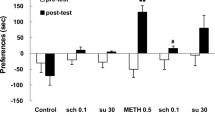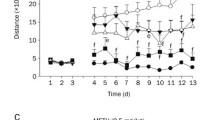Abstract
Methamphetamine (2 mg/kg SC) increased ambulation in mice for about 3 h, with a peak effect at around 40 min after the administration, and its repeated administration induced sensitization. Both SCH 23390 (0.03 mg/kg SC) and haloperidol (0.4 mg/kg SC), dopamine D1 and D2 receptor antagonists, respectively, completely inhibited not only the acute stimulant effect of methamphetamine but also its sensitization when repeated methamphetamine was repeatedly combined with either of these drugs. Moreover, treatment with SCH 23390 2–5 h or haloperidol 1–5 h after each methamphetamine administration significantly antagonized methamphetamine sensitization. The maximal inhibitory effect was observed in the schedules of 3-h post-methamphetamine treatment for both drugs. However, treatments with SCH 23390 or haloperidol at 0.5 h, 6 h and 24 h after methamphetamine had no such inhibitory effect. The mice treated with SCH 23390 or haloperidol after each saline administration (the control administration for methamphetamine) did not show significant change in the sensitivity to methamphetamine. These results suggest that methamphetamine has an effect on both dopamine D1 and D2 receptors for several hours even after cessation of its acute stimulant effect, and that such an effect is involved in the induction of sensitization to the stimulant effect of methamphetamine on ambulation in mice.
Similar content being viewed by others
References
Beckett AH, Rowland M (1983) Urinary excretion of methamphetamine in man. Nature 206:1260–1261
Demellweek C, Goudie AJ (1983) Behavioural tolerance to amphetamine and other psychostimulants: the case for considering behavioral mechanisms. Psychopharmacology 80:287–307
Hirabayashi M, Alam MR (1981) Enhancing effect of methamphetamine on ambulatory activity produced by repeated administration in mice. Pharmacol Biochem Behav 15:925–932
Iorio LC, Barnett A, Keitz FH, Houser VP, Korduba CA (1983) SCH 23390, a potential benzazepine antipsychotic with unique interaction on dopaminergic synthesis. J Pharmacol Exp Ther 226:462–468
Kilbey MM, Sannerud CA (1985) Models of tolerance: do they predict sensitization to the effect of psychomotor stimulant. In: Seiden LS, Balster RL (eds) Behavioral pharmacology: the current status. Alan R. Liss, New York pp 295–321
Kuribara H (1994a) Can post-treatment with dopamine D1 and D2 antagonists inhibit methamphetamine and cocaine sensitizations by means of ambulatory activity in mice? Jpn J Pharmacol 64 [Supp. I] 179P
Kuribara H (1994b) Early post-treatment with haloperidol retards induction of methamphetamine sensitization in mice. Eur J Pharmacol 256:295–299
Kuribara H (1994c) Can posttreatment with the selective dopamine D2 antagonists, YM-09151-2, inhibit induction of methamphetamine sensitization? Evaluation by ambulatory activity in mice. Pharmacol Biochem Behav 49:323–326
Kuribara H, Tadokoro S (1982) Circadian variation in methamphetamine and apomorphine-induced increase in ambulatory activity in mice. Pharmacol Biochem Behav 17:1251–1256
Kuribara H, Tadokoro S (1984) Circadian variation in sensitivity to methamphetamine after repeated administration in mice. Pharmacol Biochem Behav 20:247–250
Kuribara H, Tadokoro S (1990) Effects of YM-09151-2, a potent and selective dopamine D2 antagonist, on the ambulation-increasing effect of methamphetamine in mice. Jpn J Pharmacol 52:489–492
Kuribara H, Uchihashi Y (1993) Effects of haloperidol on the methamphetamine sensitization: assessed by ambulatory activity in mice. Jpn J Psychiatry Neurol 47:661–668
Kuribara H, Uchihashi Y (1994) Effects of dopamine antagonism on methamphetamine sensitization: evaluation by ambulatory activity in mice. Pharmacol Biochem Behav 47:101–106
Lewander T (1971) A mechanism for the development of tolerance to amphetamine in rats. Psychopharmacologia 21:17–31
Mailman RB, Schultz DW, Lewis MH, Staples L, Rollema H, Dehaven DL (1984) SCH 23390: a selective D1 dopamine antagonist with potent D2 behavioral actions. Eur J Pharmacol 101:159–160
Robinson TE, Becker JB (1986) Enduring changes in brain and behavior produced by chronic amphetamine administration: a review and evaluation of animal models of amphetamine psychosis. Brain Res Rev 11:157–198
Tadokoro S, Kuribara H (1986) Reverse tolerance to the ambulation-increasing effect of methamphetamine in mice as an animal model of amphetamine psychosis. Psychopharmacol Bull 22:757–762
Tadokoro S, Kuribara H (1990) Modification of behavioral effects of drugs after repeated administration; in particular, the reverse tolerance to amphetamines. Folia Pharmacol Jpn 95:229–238
Terai M, Usuda S, Kuroiwa I, Noshiro O, Maeno H (1993) Selective binding of YM-09151-2, a new potent neuroleptic, to D2-dopmine receptors. Jpn J Pharmacol 33:749–755
Author information
Authors and Affiliations
Rights and permissions
About this article
Cite this article
Kuribara, H. Inhibition of methamphetamine sensitization by post-methamphetamine treatment with SCH 23390 or haloperidol. Psychopharmacology 119, 34–38 (1995). https://doi.org/10.1007/BF02246051
Received:
Revised:
Issue Date:
DOI: https://doi.org/10.1007/BF02246051




